May 14, 2009
Routines and Tip - 2
Workout on Mon/Wed/Fri/Mon and alternate workouts 1/2/3/4 etc...
A favorite of mine that hits each bodypart twice per week.
Day 1
4x Squats: 5 reps
3x Ham Work: 8 reps
3x BB or DB Row: 8 reps
2x Bicep Curls: 10 reps
Day 2
4x Bench Press: 5 reps
3x Military Press: 8 reps
3x Tricep Isolation: 8 reps
2x Ab/Calf Work: 15 reps
Day 3
4x Deadlifts: 5 reps
3x Pullups: 8 reps
3x Leg Press: 8 reps
2x Biceps Curls: 10 reps
Day 4
4x DB or Incline Press: 5 reps
3x Chest Dips: 8 reps
3x Side Lateral Raise: 8 reps
2x Ab/Calf Work: 15 reps
Day 1: On
Day 2: On
Day 3: Off
Day 4: On
Day 5: Off
Day 6: On
Day 7: Off
A simple 4 day upper/lower.
Mon.
Squat 2-3 x 5
Ham Work 3 x 10
Calves 3 x 15
Abs 2 x 10
Wed.
Bench Press 3 x 5
BB or DB Row 3 x 6, 1 x 15
OH Press 3 x 8
Arms -Tri/Bi - each 3 x 8-10
Fri.
Deadlift Variant 2-3 x 5
Leg Press 2 x 10 or 1 x 20
Calves 3 x 15
Abs 2 x 10
Sun.
Incline bench 3 x 10-15
Pullups 20-40 reps
Dips 2 x 8-12
Lateral Raise 3 x 8-10
continued ...............
May 4, 2009
Routines and Tip - 1
A rotation that hits each body part once every 4-5 days.

1.
Squat 2-3 x 5, 1 x 10
Ham Work 3 x 8
BB Row 4 x 6
Bicep Iso 2 x 10
2.
Bench Press 3 x 5
Dips 3 x 8
Side Laterals 3 x 10
Tricep Iso 2 x 10
3.
Deadlift 3 x 5
Leg Press 2 x 10 or 1 x 20
Pullups 20-40 reps
Bicep Iso 2 x 10
4.
DB or Incline Bench 3 x 5
Flyes 3 x 8-12
OH Press 3 x 6-8
Tricep Iso 2 x 10
Workout on Mon/Wed/Fri/Mon and alternate workouts 1/2/3/4 etc...
Another rotation that hits each body part once every 4-5 days but using a little more volume.
1.
Squats 3 x 5, 1 x 10
Ham Work 3 x 8-10
Pullups 20-40 reps
BB Rows 4 x 6
Curls 2 x 10
2.
DB or Incline Bench 2 x 5, 2 x 8
Dips 2 x 8
DB OH Press 3 x 8
Side Laterals 2 x 10
Skulls 2 x 10
3.
Deadlifts 2-3 x 5
Leg Press 2 x 10 or 1 x 20
Chins 20-40 reps
DB Rows 3 x 8
Curls 2 x 10
4.
Bench Press 2 x 5, 2 x 8
DB Flyes 2 x 8-12
Military Press 3 x 8
Side Laterals 2 x 10
Skulls 2 x 10
To be continued ...............
May 2, 2009
Routines and Tip

First a few basic points to consider.
1) Don't copy the workout routines of advanced guys that are already big, and strong.
The training style of someone who is already strong, and has experience under his belt maybe very different to a newbie. Don't look at these guys training styles and think that you need to train their way straight off. These guys have built up their work capacity, and also through experience, know how to fine tune a workout to address their own personal strengths and weaknesses.
2) No one single training style is optimal for everyone.
There are many styles of training and while a training system maybe optimal for someone at a given time, no one training style will be optimal, for everyone, at all times. We must experiment and find what works for us as an individual, because that's what you are, unique, so while somebody else may gain well on program A, program B may be more suited to you. The best way to find out? Try!
3) Keep your routine simple, basic and focus on getting stronger.
The best thing a new lifter can do is train to get stronger on the core lifts, compound (multi-joint) movements:
Squats
Dead lifts
Bench
Rows
Dips
Chins
Overhead pressing
These are the things to focus on, and get good at. Think how much bigger you'd be if you concentrated on the above lifts for a year or two and added significant amounts of weight to each! I'm not suggesting to leave out isolation (single-joint) exercises, these are certainly beneficial but the above movements and their variations are the money makers especially for beginners.
4) Avoid extremes to begin with.
At either end of the spectrum we have lifters that perform high workloads of 20 (ish) sets per body part. At the other we have the single set to failure (SSTF) lifters who use just one work set per exercise but take that one set to it's absolute limit (failure) and possibly beyond using set extending techniques. I am of the opinion that for the majority of beginners to intermediate lifters that moderation is the key. Moderate workloads (volume) and muscular failure avoided for the most part. This results in a decent load on the muscular system while helping to avoid the systematic fatigue caused by too much use of taking sets to failure and possibly beyond.
A simple 3 day routine. Each body part once per week. Each exercise 2-4 sets, reps 5-8.
Back/Bis
Dead lifts
A Row
Chins or Pulldown
Bicep Curl
Chest/Tris
Bench
DB or Inc Bench
Chest Dips
Triceps Isolation
Legs/Shoulders
Squat
GHR (Glute Ham Raise)
Military Press
Calf Work
To be continued ...............
Apr 30, 2009
College Training
As most bodybuilders know, developing lean mass takes more than training hard in the weightroom, but also eating a clean and adequate diet. In a college atmosphere, eating a clean and adequate diet is not always an option when you are at the dining halls that serve objects that barely resemble food or at a party full of people that usually drink their dinners.
Normal dining halls and meal plans offer three square meals a day, which falls a bit short for hard training athletes. So when you are at the dining hall you have to get the most for your money here. Look for foods that are fit your goals so look for lean meats, complex carbohydrates, fruits, and a good salad bar.
Some foods you can look for are:

It is also very important to schedule times throughout the day for training and for eating. Try spacing out your classes so that you have time for a quick meal. If you have too many classes in a row then try eating during class because most professors do not mind. Also when you are at the dining hall bring some Tupperware with you so that you can sneak some extra food out enabling you to eat every couple hours.
College TrainingMake training time sacred. College is full of distractions but make sure you allot yourself at least an hour a day to do some kind training. Personally when I schedule for classes I leave at least a three hour block open for training at a time where I know the gym will not be overcrowded with people. Another option is to train early in the morning. Most people do not get to the gym before noon, so I have learned that the gym is usually empty early in the morning. This allows you to train before class and have the rest of the day to repair.
Apr 29, 2009
Six-Pack Abs
The basic crunch is performed while lying on the floor with your feet flat on the ground, arms either crossed in front of you or hands behind your head and crunching your upper body toward your knees. Your lower back should not come off of the ground, just your upper torso. Crunch your abs and exhale as you come up. Squeeze for a second and then return without taking tension off of the midsection.


For sit-ups assume the same starting position then curl up your entire upper body into your knees. Uncurl and return to the starting position. Try not to use your lower back, instead let your abs curl you up.
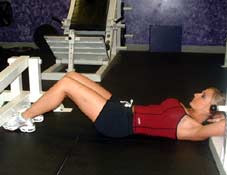

Quick Hit:
There are many forms of the crunch to choose from such as performing them on a flex-ball, feet supported on a bench, and weighted by holding a small weight plate on your chest.


Another way to try weighted crunches is to lie on the floor with your head toward a rope attachment on a low pulley and pull the weight up while you crunch. Make sure to hold the ends of the rope on either side of your head when crunching.
A great way to make the sit-up more difficult is to perform them on a decline bench and hold a weight plate on your chest with crossed arms. This would be a bit of a challenge, so try it with a weight you can handle first.
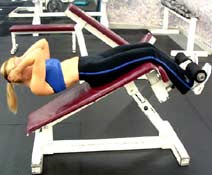
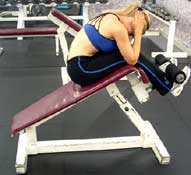
Leg Raises:
The leg raise is performed while lying face up on the ground with your hands slightly out to your sides palms down on the floor for support. With your feet together, lift your legs with a slight bend in the knees until they are just short of perpendicular to the floor. Lower to the starting position without letting your heels touch the floor and repeat.

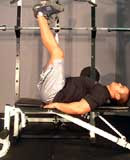
Quick Hit:
For a more of a challenge leg raises can be performed on a decline bench. This will require you to raise your legs over a wider range of motion for a more difficult and effective contraction.


Hanging leg raises or knee raises are two more alternatives to really hammer the lower abs. While hanging from a chinning bar raise up your legs as in the lying raises and stop when your legs are at parallel with the floor and return. For knee raises bring your knees into you abdominal region until they are past parallel and squeeze. Lower and return as with leg raises.
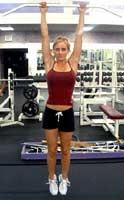

Side Crunches:
Lay down on the floor on your side with both hands behind your head - use a foot support if necessary to stabilize your lower body. Crunch up on your side while your hip remains in contact with the floor. Squeeze at the top for a second and then return to the starting position and avoid resting your upper body. Switch sides and repeat.


Bicycles:
As one of the most effective ab exercises out there (especially for the obliques) the bicycle is not only challenging, but when done correctly, can grant you great overall ab development.

Lie on the ground with your hands behind your head and your feet slightly off of the ground. Start alternating your elbows to knees. Twist your torso so that your left elbow reaches your right knee and then vice versa. Keep alternating while keeping your shoulders off of the floor. Squeeze the obliques with every contraction.
Quick Hit:
You can make this movement a bit more challenging and isolate one set of obliques at a time by focusing on one side and then switching over to the other. Just perform all reps for one side then switch and do the allotted number of reps for the other.
Russian Twists:
This movement is not for the weak at heart. Seat yourself on a Roman chair or a decline sit-up bench where your upper body is suspended.
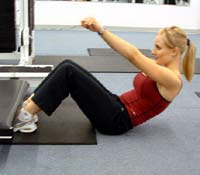
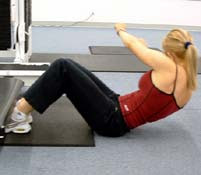
Hold a weight plate or medicine ball out in front of you with your arms straight. You will begin to twist only your upper torso to one side as far as you can comfortably go then twist to the other. Keep twisting - but keep the movement somewhat at a slow pace. You do not want to jerk the weight around and injure your lumbar in any way.
Quick Hit:
For those that find it difficult utilizing a weight plate or medicine ball with this movement simply clasp your hands in front of you and perform the exercise as usual. This will build up your strength so you may graduate up to using weight in the future.
Plank:
Utilized as a standard for core strength and development, the plank is not a movement at all. It is a stability exercise used mainly to build the transverse abdominus.
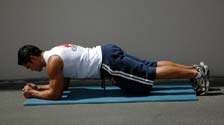
Simply assume a standard push-up position except hold yourself up by your elbows instead of your hands. Keep your stomach tight and drawn in slightly to activate your core muscles. Hold this position for 20 to 30 seconds and then rest - this will be counted as one set.
Side Plank:
Much like the plank, the side plank works the core but on either side for lateral stability. With your body straight lie on your side while holding yourself up by you elbow and your feet together. You can place your other arm either straight down your other side or on your waste. Again, hold the position for 20 to 30 seconds and repeat for the other side.
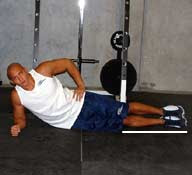
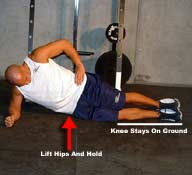
Quick Hit:
To give you a bit more of a challenge, try switching from a side plank to a normal plank over to another side plank slowly. Be sure to keep the body aligned and perform the movement in a steady, fluid motion.
Click Here!
REFERENCE:-
BODYBUILDING